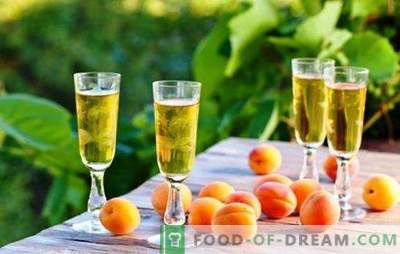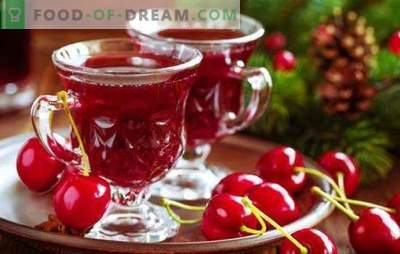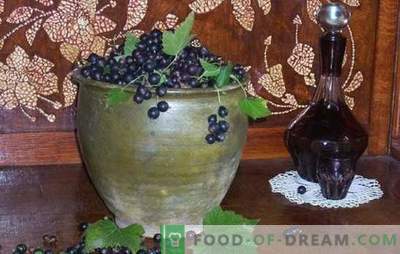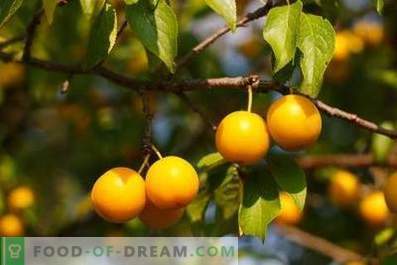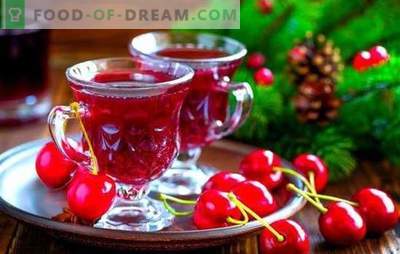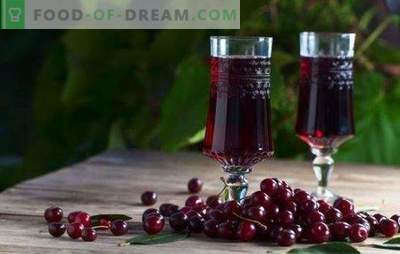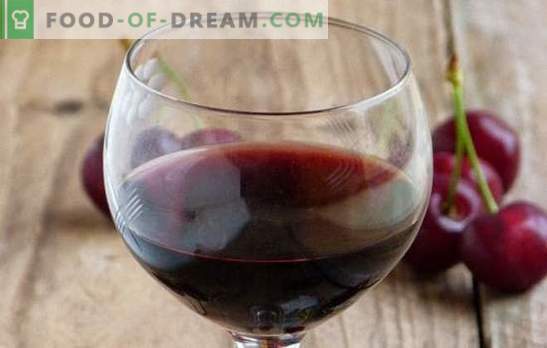
Winemaking is one of the oldest crafts mastered by man, as evidenced by archaeological sites.
Although the main elite raw material for making wines is grapes, the cultivation and selection of which is in the zone of special attention of the most famous producers, the list of fruit and berry material for the production of the rest still remains quite impressive, even without considering the fruits used exclusively in home wine cooking
Homemade Cherry Wine - Basic Technological Principles
Perhaps, sweet cherry belongs to the category of those wine materials that are used only in home winemakers. It has a very delicate and exquisite aroma. Many people like the taste of this berry too, but for the production of any wine, including homemade cherries, these criteria are not enough.
Wine raw materials should have special properties necessary for participation in the fermentation process: sugar content, acidity, high juice content and good secretion.
Sugar is needed to maintain the energy of the yeast. As a result of sugar processing, yeast produces alcohol and carbon dioxide. At the same time, an excessive amount of sugar, as well as its deficiency in wort, slows down the alcohol fermentation. This is due to the peculiarities of the vital activity of yeast, which, to put it briefly, is built on the principle of competition and energy conservation. That is, with a lack of sugar, the yeast stops growing and multiplying, economically spending energy resources for the number of an already existing colony, with the principle “there will not be enough for everyone”. With an excessive sugar content, yeast, as it were, without worrying about tomorrow, does not rush to work: the natural pattern is present even in the “society” of microorganisms. Therefore, the sugar in the wort should not be much, but not enough, so that the yeast had something to strive for. Yeast feeds on simple protein (or nitrogenous) substances, as well as minerals. Of the mineral substances, yeast is especially necessary for the growth and reproduction of potassium and phosphorus, and to a lesser extent, magnesium, calcium.
A moderately acidic environment helps the yeast to cope with other types of microorganisms: the yeast, among its direct relatives, other microorganisms, has dangerous enemies that prevent them from living and developing. A too acidic medium for yeast is just as dangerous as a low acid one. The high acidity of the wort activates microorganisms that cause not alcohol, but acetic fermentation, and in a little acidic environment other harmful bacteria develop that suppress the viability of the yeast. The normal acidity level for yeast is pH 3.5.
Another major factor that provides a favorable environment for wine yeast is temperature. The optimum temperature norm for alcoholic fermentation is the range from 20C to 30C. At this temperature, the fermentation process takes place in the normal range. Just in case, remember two more critical temperature marks: at a temperature of 10-11C, the yeast “hibernates”, which is detrimental to future wine, and the temperature of 40C can kill the yeast in an hour and a half. Intermediate marks between the lower and upper thresholds of the temperature sensitivity of yeast are also not desirable, because they change the taste of wine, if briefly explained, without delving into the essence of this rather complex biochemical process.
Now a few words about cherries, as about wine. This berry, both white and black, has a relatively sufficient sugar content, but unsatisfactory acidity. In view of this, the sweet cherry must requires the addition of acid. Often, to create a normal sour wort, white currants are added to the white cherries.
White sweet cherries get golden or yellow dessert and liqueur wines. With a sufficient number of berries in the high-yielding year, you can make strong and table wines. Black cherry gives a wine of rich dark red color, the same sorts of wine as white cherry, only worse is table wine. If there is an opportunity to get wild forest black cherries, then it would be nice to use it for blending with garden varieties. Despite the fact that the wild berry has a frank bitterness, after aging the wine for more than 9 months, it gets a pleasant taste, with a piquant tinge that resembles the taste of vermouths.
Homemade cherry wine can be natural, but blended wines will also be interesting.
The whole process of making wine from cherries at home consists of the following steps:
Preparation of raw materials;
Getting juice and determining its quality;
Cooking wort, adding yeast;
Fermentation;
Pouring wine;
Exposure and ripening;
Bottling
Certainly at each stage requires the care of wine and constant monitoring of it. But in order not to bore our readers with a long lecture on the theory of winemaking, let us turn to practice. It is better to learn from your own experience, so let's move on to the recipes.
Recipe 1. White sweet homemade sweet wine made from yellow, garden cherry
Composition:
Berries of yellow cherry 10 kg (6 liters of juice)
Tartaric acid 90 g
Tannic acid 30 g
Sugar 6 kg
Wine sourdough 0.5 l
Water (purified) 4 L
Cooking:
Enumerate the berries, wash, remove the bones. Grind a small amount of cherries can be in a meat grinder. Boil the water and dissolve the sugar in it. Cool the syrup to room temperature and pour into the wort. Stir and add the wine sourdough. Pour the wort into the bottle (15-20 liters). The volume of the bottle should be larger by 1/3 of the volume of the wort so that there is room for fermentation. Wear a rubber glove on the neck. Place the fermentation bottle in a room where the optimum temperature for the yeast is maintained.
The first removal from the sediment can be carried out when the fermentation process is completed. After that, the wine poured into a clean container is left for aging and clarification, re-removed from the sediment: gently decant, trying not to hook the sediment at the bottom, using a rubber or plastic tube. The wine is bottled and stored in a dark, cool place.
Recipe 2. Cherry liqueur white wine at home
Composition:
Yellow cherry 5 kg
Sugar 2 kg
Cherry leaves, fresh 8-10 pcs.
Muscat 1 nut, crushed
Vanilla stick 1 pc.
Vodka (40%) 2.5 L
Cooking:
Prepared berries are made into pulp and mixed with sugar, crushed nutmeg and vanilla are added. Soak the wort for 8-10 days at 20-25C and fill it with vodka. The duration of the infusion is not less than a month. After the liqueur must be filtered, squeeze the pulp and pour into a clean and transparent dish. Incubate until clarification and remove from sediment. Bottle.
Recipe 3. Blended homemade wine made from cherries and white currants
Composition:
Sugar 6 kg
White currant pulp 3 kg
Sweet cherry, white 10 kg
Wine yeast 5 g
Water 3 l
Cooking:
In a large bottle with a capacity of 20 liters, place the coarsely chopped pitted sweet cherry, crushed currant berries. Dissolve sugar in water. Add warm syrup to the berries. Add the yeast by mixing the wort, cover the neck with a cotton or gauze pad. The yeast must breathe until the active fermentation phase begins, but other microorganisms must not enter the bottle. Twice a day, stir the wort until the fermentation begins. When foam appears on the surface, close the bottle with a water seal. Monitor the temperature at which the bottle is located until the end of fermentation. Then proceed as described in recipe number 1.
Recipe 4. Sweet cherry wine at home: red vermouth
Composition:
Red Cherry Wine (16%) 10 L
Flower honey, lime 1.5 kg
A mixture of herbs - 100 g
Vodka 1.0 l
Cooking:
The composition of the herbal collection should include yarrow, wormwood, nutmeg, cinnamon, thyme, mint, cardamom. All these herbs are poured with vodka and insist in a dark place, shaking the can daily for at least three weeks. The tincture is carefully filtered, mixed with honey and added to red wine made from cherry. Stir the beverage and seal the bottle tightly. In a month home vermouth is ready.
Recipe 5. Homemade red and wild cherry wine
Composition:
Sourdough on the basis of raisins 0.5 l
Sweet cherry, black, garden 15 kg (10 l of juice)
Sweet cherry, forest 3 kg
Red currant juice 2 l
Sugar 7.5 kg
Cooking:
Pulp of prepared berries, seedless, combine with sugar and red currant juice (you can use crushed berries - 5.5 kg). Put the prepared wort into the bottle, and close it so that no impurities can penetrate the future wine. Once the juice has separated, add warm sugar syrup (dissolve the sugar in 5 liters of boiled water, cooled to 25C). Stir the wort carefully and add the wine sourdough prepared in advance from 200 g raisins, 100 g sugar and 200-300 ml of water. Sourdough is prepared a week before the start of work.
Further preparation of the wine is described in the recipes above, but the wine with forest cherries should be kept ready from 9 months to a year.
Recipe 6. Sweet cherry wine at home, strong red
Composition:
Tannin 15 g
Citric acid 50 g
Sugar 2 kg
Black cherry juice 9 l
Wine yeast 7 g
Cooking:
Heat the juice and dissolve all the ingredients in it. Chilled wine material enter the yeast. Cover the tank with a filter stopper: it must pass only air. As soon as gas bubbles start to rise on the surface of the bottle and foaming appears, close the container with a water lock or use a medical glove with a pierced finger.
After the cessation of fermentation, leave the wine in a cooler place: wait for its clarification, remove from the sediment and proceed to spill.
Recipe 7. Yellow Cherry Homemade Wine with Gooseberry
Composition:
White gooseberry 3 kg
Sweet cherry 9 kg
Raisin 0.5 kg
Sugar 6.5 kg
Cooking:
From the prepared berries of a gooseberry and sweet cherry make a pulp, add raisin and sugar. Place the wort in the bottle and add warm, boiled water to cover the surface of the mash by 5 cm. Close the bottle with a gauze napkin and hold until fermentation begins. Put the shutter and transfer the container to the end of fermentation in a room with a stable temperature regime of 20-25C. As soon as the bubbling stops, move the young wine to a cooler room for clarification. The wine will become completely transparent after precipitation. Strain it and let stand again in a clean container. Carefully remove from sediment. Pour into champagne bottles, having previously put 30 g of sugar in each. Close the bottles tightly, fasten the corks with wax or metal wire. Place them horizontally on the shelves in the basement. It is desirable that they lie for a year at a temperature of 12-14C. Get a very interesting sparkling wine.
Homemade Cherry Wine - Tips and Tricks
If the berries are difficult to separate from the bones, then pre-scald them with boiling water, squeeze out the juice, while avoiding crushing the bones. The presence in the wort 30% seed is allowed, without harm to the wine. At the same time, cherry wine will have an almond aroma.


